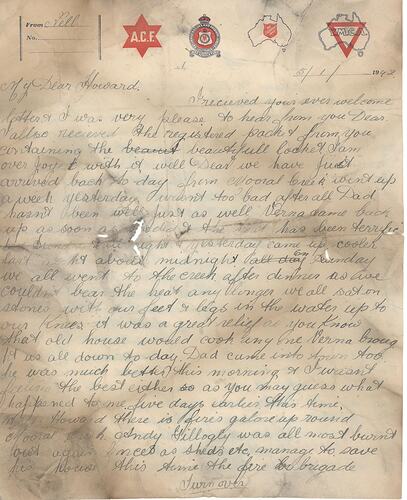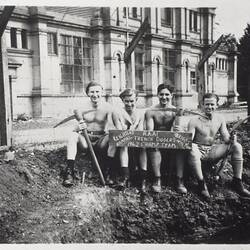Summary
Built in 1879 to host Victoria's first international exhibition, the Royal Exhibition Building (REB) has played a significant role in the political, cultural, economic and social history of Australia. The collection illustrates significant periods and uses of the Royal Exhibition Building and Carlton Gardens. The best represented events are: 1880 Melbourne International Exhibition (MIE), the 1888 Melbourne Centennial International Exhibition (MCIE), and the opening of the first federal parliament of Australia in 1901. As well as objects exhibited at the two international exhibitions, the material relating to these events includes official and souvenir guidebooks, plans, photographs, invitations, tickets and souvenirs. The Museum also maintains a REB research archive of over 6000 folders containing copies of documents, newspaper articles, photographs, fliers, and so on.
During World War II, the Royal Exhibition Building (REB, then called simply the Exhibition Building) in Melbourne was occupied by the RAAF and the WAAAF - mostly non-crew aircraftmen and aircraftwomen, trainers and administrators. Decades later, in 1989, works to replace floorboards in the REB uncovered over 270 personal items that had been pushed into holes in the floor during World War II by personnel stationed there, including intimate letters, food and personal effects. These items were never expected or intended to survive, and offer a rare unfiltered record of a time lost to public memory. Some of the items include personal names - of servicemen, families and girlfriends. Three of the letters relate to one person: Leading Aircraftman Howard Kellehear.
Howard Frederick Kellehear was born in 1905 in Blacksoil, NSW. He was described as a 'strong type of country bush worker but never went to school' in a letter of recommendation for the RAAF (service record, p.94), but was able to read and write. He married Ellen (Nell) Mary Slater in Taree in 1929; they were to have six children, five born by 1939 (Neita, John, Gay, Patricia and Valma). He worked as a labourer and bush worker, including hauling and cutting logs, and was also unemployed for a time (service record note). In 1936 he became a night watchman in Wingham.
Howard enlisted to serve in World War II in 9 September 1941 in Sydney, aged 35 (service no. 60818). He was assessed as 'of good character, sober, honest, and respectable' (service record, p.82). Lacking education, he hoped to become a cook, having been a camp cook for 'a few men' and with (cooking) 'experiences at home'. His initial test noted that he had a 'fair knowledge of plain cooking . no knowledge of fancy cooking' (service record, p.96). He was approved as a trainee cook, and from 28 September 1941 was based at "1 S.T.T. Exhibition" (service record, p.95). He soon fell ill, however, and on 21 October the Wingham Chronicle reported that he was 'seriously ill in hospital' in Melbourne. He took 79 days of sick leave from 4 October to 21 December, and another week in January 1942. Not surprising perhaps, Howard failed his trainee cook's course, but on 1 April 1942 was passed as an Aircrafthand.
In January 1942 he received three letters from his wife, all written in January 1942, which he placed or lost between floorboards on the balcony level of the Exhibition Building. The letters were found in 1989 during a restoration program, and are held in the collection of Museums Victoria (SH 960292-94). One letter was addressed from their home in Bent Street, Wingham, NSW (south of Port Macquarie on the central coast). We learn from Nell that he missed Christmas 1941 with family; that he has been feeling miserable and has been unwell; and that he writes to Nell regularly, and has sent her a locket. She encourages him to go to church - and to 'go out a little I don't mind because I can trust you' - but also tells him 'please don't drink any more beers until you are really well' (5 Jan 1942). She is sending him a tin of biscuits - 'I'm sure they will be a change.' Howard has also been undertaking a training course.
Howard took leave in April 1942 before leaving 1 S.T.T. Exhibition on 2 May 1942 for RAAF Base Rathmines, a flying boat base only a two-hour drive south of Wingham, where his family was living. He took leave again in May, July and September 1942, and was home again in March 1943. On 2 April 1943 AC1 (Aircraftman Class 1) Kellehear was given a farewell before overseas service at the Red Cross tea rooms in Wingham that was written up in the local paper. The mayor was quoted as saying he had 'always been a good citizen and a good husband, and those two qualities are a great thing in our national life.'
Howard served overseas from 13 May 1943 to 13 September 1944. He was at 41 OBU (Operational Base Unit) from 13/5/43, possibly at Dobodura Airfield in western New Guinea. From 16/7/43 he was at 4 ACS (Airfield Construction Squadron), formed as No. 4 Mobile Works Squadron in December 1942 and operating in New Guinea Campaign and Borneo.
He came back to Australia mid-1944, then went to Melbourne (page 26 of his service record indicates he was again at 1 S.T.T., leaving 2 May 1944, but this may be an error as he had left 2 May 1942). From 25/8/44 he was at 7 ACS (Airfield Construction Squadron) in Mt Martha, Victoria. He had a period of leave in September 1944 and was based at 2 PD (Personnel Depot) from 23/12/44. He was discharged on 13 March 1945 'to resume civil occupation'. He wanted to work as a farm hand for a dairying company, Machin Bros of Wingham. His release was delayed as he was in hospital again, this time at No. 2 RAAF Hospital (Ascot Vale) (no. 3 in some documents).
After the war Howard and his family lived Wallsend, Newcastle. He passed away in 1972, aged 67, and was buried in Sandgate Cemetery.
References
1936 'News in Brief.', The Wingham Chronicle and Manning River Observer (NSW : 1898 - 1954), 4 December, p. 5. , viewed 28 May 2020, http://nla.gov.au/nla.news-article167106365.
1940 'Obituary.', The Wingham Chronicle and Manning River Observer (NSW : 1898 - 1954), 19 July, p. 4. , viewed 28 May 2020, http://nla.gov.au/nla.news-article168507721.
1941 'Personal.', The Wingham Chronicle and Manning River Observer (NSW : 1898 - 1954), 21 October, p. 2. , viewed 28 May 2020, http://nla.gov.au/nla.news-article168506373.
1942 'News Of Our Soldiers.', The Wingham Chronicle and Manning River Observer (NSW : 1898 - 1954), 24 April, p. 2. , viewed 28 May 2020, http://nla.gov.au/nla.news-article168514297.
1943 'Wingham and District Patriotic Association.', The Wingham Chronicle and Manning River Observer (NSW : 1898 - 1954), 6 April, p. 3. , viewed 28 May 2020, http://nla.gov.au/nla.news-article168391439.
'No. 4 Airfield Construction Squadron (4ACS)', Virtual War Memorial Australia, https://vwma.org.au/explore/units/1999, accessed 17/9/20
Kellehear, Howard Frederick, service record barcode 4599106, NAA
'Dobodura Airfield', https://ww2db.com/facility/Dobodura_Airfield/, accessed 17/9/20.
Find a Grave index, https://www.findagrave.com/memorial/180157530, accessed 29/5/2020.
G. O'Brien, 2009. 'Always There A History of Air Force Combat Support', p.41 (41 OBU)
More Information
-
Keywords
-
Authors
-
Article types




